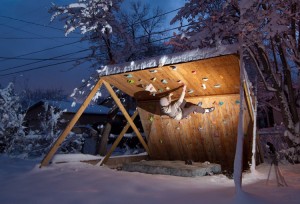Trust me I am no expert at route-setting however it is the second most crucial element of your climbing wall besides your actual wall.
There are whole websites dedicated to the art of routesetting with the best being: http://www.routesetter.com/
Professional routesetting is definitely an art-form and one that a home-woody owner will need to appreciate in order to get the most out of your wall. The difference between a professional that is paid to set routes in a gym and your wall is that they get a lot more practice and real-time feedback then you do. They will set hundreds of routes and can instantly tell if it is too awkward, hard, or easy by just watching the hoards of people climbing their route.
Before beginning I also have another post that discusses “Holds for Your First Wall” and has a few points on basic routesetting here: http://andylibrande.com/homeclimbingwall/2010/08/holds-for-your-first-wall/
Practical Tips:
- Have a defined start hold(s) and finishing Jug(s)
- Don’t just put up a bunch of holds randomly. Instead build a sequence from start to finish.
- Set a number of defined routes on your wall and build on variations. (ex: on a 8 ft wide wall we will set 3-4 solid problems and then build 3-4 variations off of those)
- When setting cruxes have them be higher on your problems. (No one likes getting shut-down on the start)
- Fore-run your routes and do not be afraid to change/tweak them
- This is probably the biggest mistake new route-setters do. Set the problem then climb on it (and have others climb on it). Then adjust as necessary such as moving the holds further/closer, adding more feet, turning the hold, etc
- Practice and fore-running make perfect
Philosophical Tips:
- Keep it simple at first:
- You have limited resources (ie holds/placements) therefore keep the movements simple and build into more complex movements.
- Explore your Wall:
- If your wall is brand-new to you then explore the different movements that maximize the number of moves on a wall
- Set routes where the crux is high and several moves in
- This gets all ability types multiple moves into the sequence and keeps motivation high
- When the wall feels stale remove all holds and start again
- Two people routesetting a home woody is always fun and a good way to build off of each other’s ideas
Tips to Set for Easier Routes (aka the secret of the singles:
- One of the first things to open my eyes to routesetting was this article on Routesetter: “Secret of the Singles” http://www.routesetter.com/2007/10/15/the-secret-of-the-singles/
- In the article it talks about how the really great routes and the best routesetters can set really fun but challenging climbs below the 5.10 mark.
- It all makes sense since this is the foundation for all climbing is the basic routes and if you can set to please the masses (aka your friends) then you will be able to build upon those principles and set really hard routes.
- Here is how I set for Easier Routes:
- On a 35 degree wall it is all about giving the climber large holds and plenty of feet
- Start with two really good holds that anyone can pull down on (usually sit-start but ensure shorter climbers can still do the sit)
- Ensure there are plenty of large feet at the bottom
- Keep movements straight-forward and obvious
- Add more feet if people are getting shut-down
- Ensure that hold selection is of the friendlier holds (so they are not ripping their hangs-up)
- Put in one surprise hold or move that they need to practice on (so it is not just a giant jug-ladder)
- Have lots of people try it so that you get an understanding of what is possible and what needs to be changed.
Routesetting is an art and as with any art the more you practice and the more variety and tools you deploy will only improve your art. Enjoy!


Recent Comments